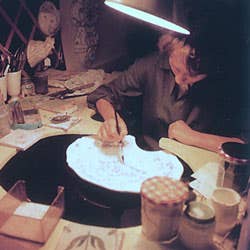
The Artful Ceramics of Moustiers
Though it is a tiny village, Moustiers-Sainte-Marie might well be the most famous town in Haute Provence—by virtue of its celebrated local industry, the manufacture of faience, or fine ceramic pottery. Inspired by local resources of water and clay, and probably taught the art by monks from Italy, local craftsmen began making delicately glazed ceramics—characterized by a milky-white background color and decorations in a shade of blue faintly tinged with lavender—as early as the mid-16th century.
The first star of the industry was Pierre Clerissy, who opened his atelier in 1651. Moustiers motifs had featured pastoral and mythological scenes and depictions of local birds and flowers. Joseph Olerys and Jean-Baptiste Laugier, a famous team of faienciers, introduced the so-called "grotesques"—fantasy figures inspired by the etchings of Jacques Callot. After Louis XIV banned gold and silver tableware in France in 1672—reserving the precious metals for the state treasury—the popularity of faience spread rapidly throughout the country, and the Moustiers style was widely copied, from Bordeaux to Burgundy to Haute Savoie.
The Moustiers ceramics industry thrived until the end of the18th century—but by 1884, as a result of changing tastes and the industrial production of pottery, the last local workshop had closed. In 1927, an artisan with the delightful name of Marcel Provence revived the industry, and today ateliers still produce Moustiers ware in the old style.
Keep Reading
Continue to Next Story










